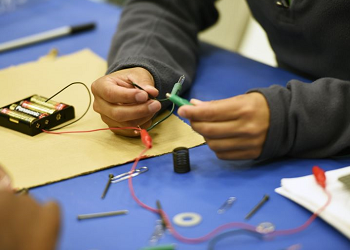When should you start your child in swimming lessons?
Young children can drown in as little as an inch of water. And it can occur without a splash.
Though August typically signifies an end to summer, Dr. Katherine Leaming-Van Zandt, an emergency medicine physician at Baylor College of Medicine and Texas Children’s Hospital, said drownings are common in Texas year-round because many families have pools in their backyards, and even more have bathtubs in their homes.
“When we think about submersion or drowning prevention, there are always different layers of prevention,” said Leaming-Van Zandt, associate professor of medicine – pediatrics at Baylor and medical director of the Texas Children’s-West Campus Emergency Center. “Start in the home by draining bathtubs, not having any buckets of water around and keeping toilet seats closed and inaccessible to children.”
Another important layer of prevention is starting swimming lessons, or at least a real introduction to water, at a young age. Every child should learn how to swim and not just for recreation, Leaming-Van Zandt said.
The timeline of when you should start your child on swimming lessons is an individual decision, and it’s dependent on the child’s age, their developmental abilities and whether they’re ready to go into a pool or body of water.
Children between the ages of 1 and 4 are at a high risk for drowning, particularly near pools and lakes. Those under the age of 1 are more likely to become submerged underwater in a bathtub.
Healthy children are physically ready for swimming lessons by age 4, but they can be introduced to water or a form of swimming lessons as soon as they turn 1, Leaming-Van Zandt said. By the age of 4, a child can learn to float, tread water and how to move to the edge of the pool and exit the pool safely.
Blowing bubbles in the water is one of the first ways children learn how to protect themselves in water.
“It’s about putting their heads underwater and teaching them at a young age that they should never swallow or inhale while they’re underwater,” she said. “This is a step to get them to a place where they can effectively swim – not in swim meets, but to be able to wade in the water and know what to do when they are in a situation unexpectedly.”
Putting a young child in swimming lessons can be fun, but it is work. While swimming schools have become more common, many people choose to teach their children to swim on their own or in a neighbor’s backyard pool.
In this case, there should be always one adult per child in the pool who is keeping a close eye on what is happening. Touch supervision is when an adult is within touching distance of the child to ensure they can quickly grab them and pull them up if they slip underwater.
Parents should aim to be CPR-certified as data shows that can significantly alter the outcomes for those that have submersion injuries, according to Leaming-Van Zandt. If a child can’t swim or is not able to exit the pool, they should wear a U.S. Coast Guard-approved life jacket.
At pool parties, a person should be assigned to be a lifeguard or water watcher, she added.
“We all think we’re watching our kids until we’re distracted. It’s easy for them to go under, and a lot of drownings are silent,” she said. “It’s not the thrashing around that we see in movies.”
Teenagers and young adults should learn to swim, especially along the Gulf Coast because of unpredictable weather patterns and rip tides at the beach. Alcohol and drug use factor into swimming safety, as well.
Leaming-Van Zandt said the bare minimum is learning how to tread water and float on your back.
“Adults are just as at risk if they don’t have the skills to save themselves or allow themselves the time to have someone help or rescue them,” she said. “This is a life and death situation, and you have to equip yourself for success in life.”
By Julie Garcia



